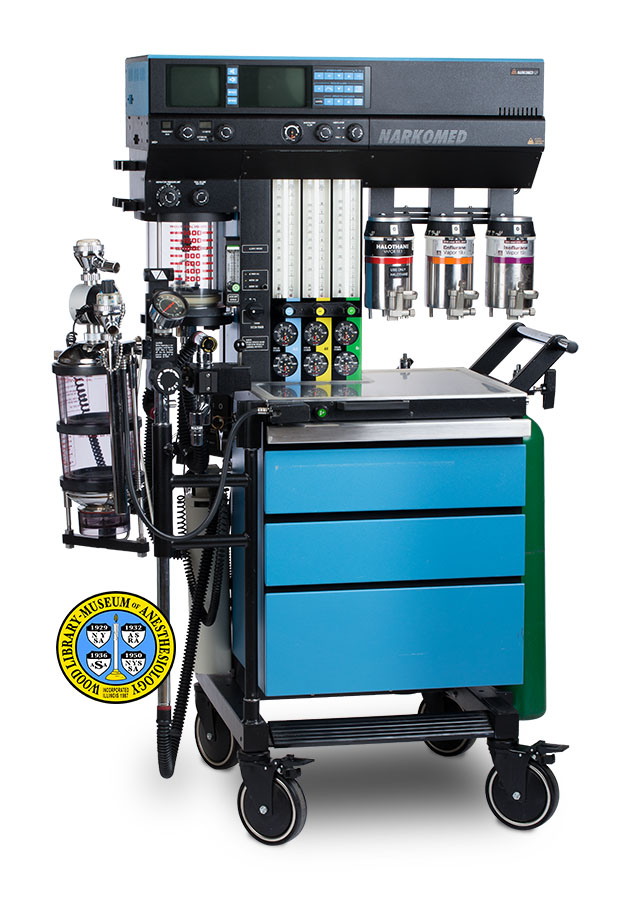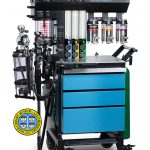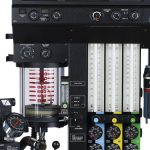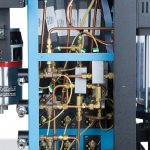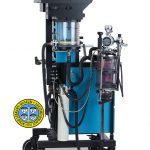Narkomed 2B
North American Dräger (NAD) was founded in 1968 by engineer Peter J. Schreiber and two partners in Telford, Pennsylvania, with financial backing from the West German company, Dräger. Before immigrating to the U.S. in 1966, Schreiber designed anesthesia equipment for Dräger. He became a driving force for the advancement of anesthesia machine design and patient safety. Mr. Schreiber was a member of the Anesthesia Patient Safety Foundation (APSF) from its inception in 1985. In 2004, the Society for Technology in Anesthesia awarded him the J. S. Gravenstein Award for lifetime achievement in that field.
NAD's first clinical anesthesia machine, the Narkomed, was introduced in 1972. The Narkomed 2B was introduced in 1987, one year after the Narkomed 3. In the model 2B, the central alarm system combined audible and visual cues. Warning alarms produced a continuous, repeating sound, while caution alarms sounded intermittently. The 2B was equipped with a positive end expiratory pressure (PEEP) valve, as well as four digital monitors that displayed graphics and other data. Purchasers could customize their machine by choosing among standard components. Additional options included the Nellcor pulse oximeter. 12,000 of the Narkomed 2B were manufactured from 1987 through 1999.
Catalog Record: Narkomed 2B Narkomed 2B
Access Key: aqkz
Accession No.: 2014-02-15-1 F
Title: Narkomed 2B / North American Dräger.
Corporate Author: North American Dräger.
Publisher: Telford, PA : North American Draeger, [between 1987 and ca. 1995].
Subject: Anesthesia, Inhalation – instrumentation.
Subject: Anesthesia Machines.
Subject: Enflurane.
Subject: Halothane.
Subject: Isoflurane.
Subject: Monitoring, Intraoperative – instrumentation.
Subject: Vaporizers.
Subject: Ventilators, Mechanical.
Note Type: General
Notes: The title is taken from the object. The first year in the date range is based on the date supplied by Cicman et al. The second year in the date range is based on the fact that four other Narkomed models are known to have had a production run of from six to seven years’ duration. According to Cicman et al., the model was still in production in 1993.
Note Type: With
Notes: One Dräger Vapor 19.1 halothane vaporizer, serial number “99121”, one Dräger Vapor 19.1 enflurane vaporizer, serial number “49473”, and one Dräger Vapor 19.1 isoflurane vaporizer, serial number “62967”.
Note Type: Citation
Notes: Andrews JJ. The anatomy of modern anesthesia machines. In: Barash PG, ed. ASA Refresher Courses in Anesthesiology, Vol. 18. Philadelphia: Lippincott, 1990:1-17.
Note Type: Citation
Notes: Cicman J, Himmelwright C, Skibo V, Yoder J. Operating Principles of Narkomed Anesthesia Systems. Telford, PA: North American Dräger, 1993.
Note Type: Copyright
Notes: North American Dräger Company File. Archives. Located at Wood Library-Museum of Anesthesiology, Schaumburg, Illinois.
Note Type: Physical Description
Notes: One anesthesia machine; Blue and black metal cabinet, with three drawers and stainless steel tabletop, mounted on four wheels; The two front wheels are equipped with brakes; The front side of the tabletop holds, from left to right, a fresh gas outlet, an oxygen flush button and a black metal handle; The back of the tabletop holds one yoke for nitrous oxide and one yoke for air; The right side of the tabletop holds one oxygen yoke with a spacer attached by a chain, a vacuum connector, and a large handle;
The left rear section of the tabletop is occupied by a flowmeter bank; This bank holds (from left to right) two nitrous oxide flowmeter tubes, two air flowmeter tubes and two oxygen flowmeter tubes; Below the pair of tubes for nitrous oxide are one control knob, one gauge for that gas administered from a cylinder, and one for that gas administered from a pipeline;
The left rear quarter of the tabletop is occupied by a flowmeter bank and other components; From left to right, the flowmeter bank holds one pair of tubes each for nitrous oxide, air and oxygen; Each pair of tubes is linked to two gauges, one for the associated cylinders and one for the associated pipeline; Each pair of tubes has one control knob; All three of these knobs are set under a bar (called the Flowmeter Control Knob Protection Assembly); To the left of the flowmeter bank, a control panel holds, from top to bottom: an oxygen supply pressure indicator, “AC Power” indicator, “Low Battery” indicator, “Battery Test indicator”, and ‘System Power’ knob with settings marked “On” and “Standby”; An “Auxiliary Oxygen Assembly” is mounted on the left side of this panel;
Above the flowmeter bank, and stretching beyond the tabletop to left and to right, there are two banks of controls and monitors, one above the other; The left half of the upper of these two banks holds two displays and associated controls; That display on the far left is accompanied by a vertical row of membrane switches marked, from top to bottom: [symbol denoting audio off], [symbol denoting audio on], “Trace” and “Trend”; That display to the left of this is accompanied by three horizontal rows of membrane switches; The switches in the upper row are marked: “OXYGEN ALARMS [new line] O2 CAL”; Those middle row are marked “PRESSURE ALARMS” and those in the bottom row are marked: “CONFIG [new line] MINUTE VOLUME ALARMS”; At the far right this upper bank is marked “[NAD logo] NARKOMED 2B”;
The lower of these two banks is marked “AV2” at the far left; This lower bank holds components, from left to right: a respiratory frequency control knob and display, marked “Frequency [new line] /min”, an inspiratory-expiratory phase/time ratio control knob and display, I:E RATIO”, an inspiratory flow control knob, a ventilator pressure control knob, a push-button marked “FAULT”, and a ventilator power knob marked “ON [new line] OFF”; To the right of these controls, this bank is marked “NARKOMED [new line] [NAD logo] NORTH AMERICAN DRÄGER”; Below this lower monitor bank and to the right of the flowmeter bank there is a back bar that can hold up to three vaporizers;
A ventilator is attached to the underside of the lower bank, at the front left corner; At the top of the ventilator is a box holding two dials, marked “Inspiratory Pressure Limit” and “Tidal Volume”, respectively; The ventilator holds an ascending bellows, and is marked with tidal volumes from 200 to 1400; Below this, at the rear of the left wall of the machine, there is a gas scavenger; The scavenger is marked: ” Model: 4106362 [new line] Ser No: 22953″; In front of this, a bracket on the left side of the machine holds a Positive End Expiratory Valve, marked: “Model: PEEP-ABS [new line] Ser No: 25136”; A separate, swiveling bracket holds a double-canister carbon dioxide absorber; A Volume Sensor is attached to the top of the absorber; The sensor is marked: “Model: 4106362 [new line] Ser No: 22953”;
Note Type: Physical Description
Notes: The back of the machine holds a power cable with grounded standard US/NEMA 5 plug and IEC320 connector with lock; An adhesive label on the left rear leg of the machine reads: “Tested by Elizabeth Warszawa [new line] Model/Serial Number Plate [new line] North American Dräger [new line] 148B Quarry Road [new line] Telford PA 18969 [new] Model NARKOMED 2B [new line] Ser No 16564 [new line] Made in USA”.
Note Type: Reproduction
Notes: Photographed by Mr. Steve Donisch, June 21 and 22, 2017.
Note Type: Acquisition
Notes: Gift of Mr. James Yoder.
Note Type: Historical
Notes: North American Dräger (NAD) was founded in 1968 by engineer Peter J. Schreiber and two partners in rural Telford, Pennsylvania, with financial backing from the West German company, Drägerwerk. Before emigrating to the U.S. in 1966, Schreiber designed anesthesia equipment for Dräger. The first products sold by NAD were anesthesia machines for veterinary care and anesthesia accessories, such as the Dräger Volumeter, which measured respiratory volume.
Mr. Schreiber became a driving force for the advancement of anesthesia machine design and patient safety. In addition to his patents, Schreiber authored papers in peer-reviewed journals as well as books on anesthesia machine design and safety. He was a member of the Anesthesia Patient Safety Foundation (APSF) from its inception in 1985, and served on its Board of Directors in 1998. In 2004, the Society for Technology in Anesthesia awarded him the J. S. Gravenstein Award for lifetime achievement in that field.
NAD’s first clinical anesthesia machine, the Narkomed, was introduced in 1972. The Narkomed 2B was introduced in 1987, one year after the Narkomed 3. In the model 2B, the central alarm system combined audible and visual cues, prioritized as warning alarms, caution alarms, and advisory alarms. Audible warning alarms produced “a continuous repeating tone”, to signal a problem that required immediate action. Audible caution alarms produced “intermittent tones”, while advisory alarms could produce “a single, brief tone”. The 2B was also equipped with four digital monitors that displayed information either in alphanumeric characters or graphics. Purchasers could customize their machine by choosing among standard components. Additional options included the Nellcor pulse oximeter, NAD “Vitalert” monitors, and the NAD “co-writer”, an automated record-keeping system.
Note Type: Exhibition
Notes: Selected for the WLM website.
